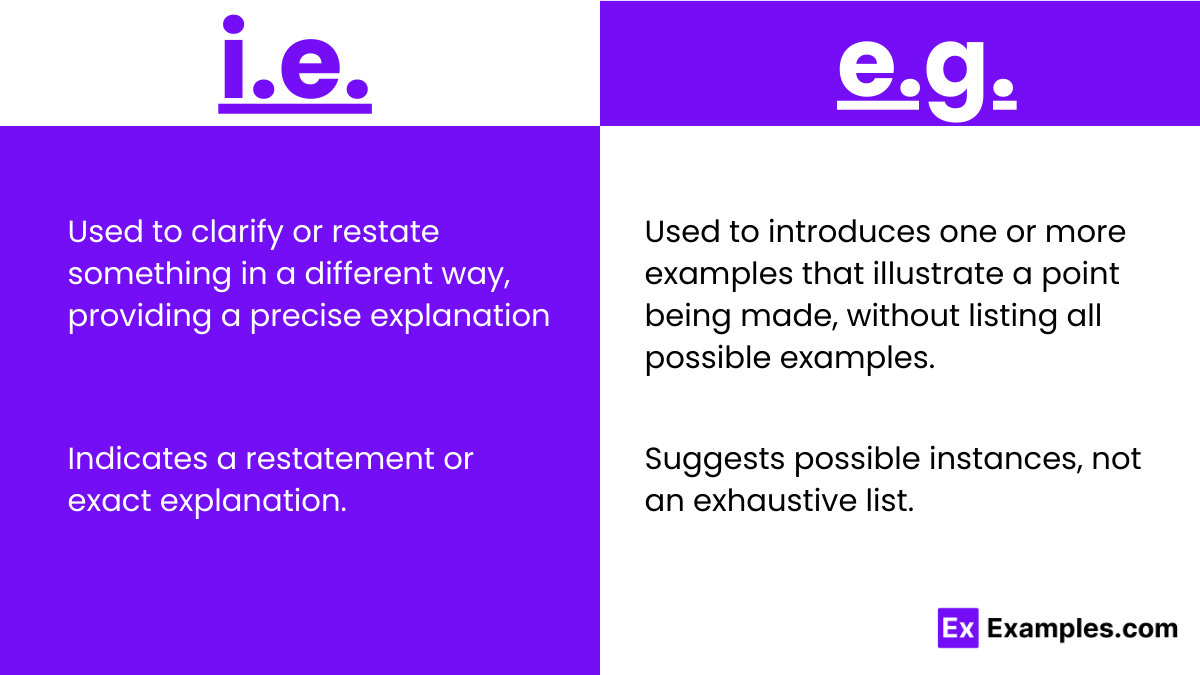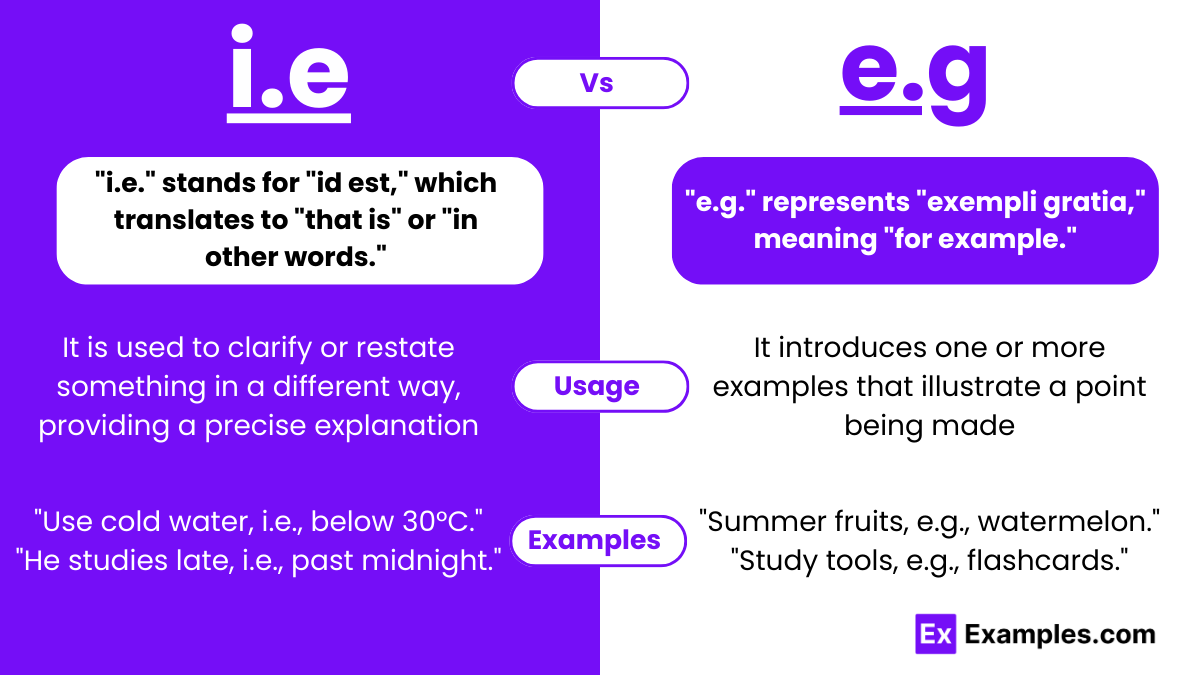i.e vs e.g – Examples, Differences, Usage
We often encounter the abbreviations i.e. and e.g., each stemming from Latin origins and serving distinct purposes. Though they appear similar, their roles within sentences are unique. “I.e.” is short for “id est,” translating to “that is,” and is employed to provide clarification or rephrase what was previously mentioned. On the other hand, “e.g.” stands for “exempli gratia,” meaning “for example,” and is used to introduce examples that support or illustrate the preceding statement. Understanding the nuances between i.e. and e.g. is crucial for precise and effective communication, as they guide readers through the intended message by either clarifying or exemplifying points made.
i.e. and e.g. – Meanings
The abbreviations “i.e.” and “e.g.” each have specific meanings and uses in the English language, originating from Latin phrases.
- “i.e.” stands for “id est,” which translates to “that is” or “in other words.” It is used to clarify or restate something in a different way, providing a precise explanation or definition. For example, “We will meet at the usual place, i.e., the coffee shop near the library.”
- “e.g.” represents “exempli gratia,” meaning “for example.” It introduces one or more examples that illustrate a point being made, without listing all possible examples. For example, “You should eat more fruits, e.g., apples, bananas, and oranges.”
Summary
The abbreviations “i.e.” (from Latin “id est,” meaning “that is”) and “e.g.” (from Latin “exempli gratia,” meaning “for example”) serve distinct purposes in English. “i.e.” is used to clarify or restate a point in another way, while “e.g.” introduces examples to illustrate a statement. For instance, “Meet at the usual place, i.e., the coffee shop” clarifies the location, whereas “Eat more fruits, e.g., apples and bananas” provides examples of fruits.
Difference Between i.e. vs e.g.
| Aspect | i.e. (id est) | e.g. (exempli gratia) |
|---|---|---|
| Meaning | “That is” or “in other words.” | “For example.” |
| Purpose | To clarify or specify. | To introduce examples. |
| Usage | Follows a clarifying statement or definition. | Precedes one or more examples. |
| Implication | Indicates a restatement or exact explanation. | Suggests possible instances, not an exhaustive list. |
| Examples | “We need to focus on renewable energy sources, i.e., solar and wind.” | “Try to eat more fruits, e.g., apples, bananas.” |
| Punctuation | Typically followed by a comma in American English. | Also usually followed by a comma. |
| In Lists | Not used for listing items. | Used to introduce a non-exhaustive list. |
| Common Mistakes | Often confused with e.g. when providing examples. | Mistakenly used when clarification is intended. |
| Tip for Remembering | Think of it as providing an “exact explanation.” | Remember it as introducing “example(s) given.” |
How to Use i.e. vs e.g.

Using “i.e.” and “e.g.” correctly enhances the clarity and precision of your writing. Here’s how to use each:
How to Use “i.e.”
- Purpose: Use “i.e.” when you need to clarify or explain something in another way. It’s like saying “in other words” or “that is to say.”
- Placement: It typically comes after a statement to introduce a clarification or definition.
- Example: “We will visit a tropical paradise, i.e., Hawaii.” Here, “i.e.” clarifies that Hawaii is the tropical paradise being referred to.
How to Use “e.g.”
- Purpose: Use “e.g.” when you want to provide examples to illustrate a point you’ve made. It stands for “for example.”
- Placement: It is used before listing examples that support your previous statement, but the list is not exhaustive.
- Example: “You should try some water sports, e.g., surfing, snorkeling.” “e.g.” introduces examples of water sports without implying these are the only options.
Tips for Remembering
- For “i.e.,” remember it as “in essence,” to indicate a precise explanation.
- For “e.g.,” think of “example given” to hint at offering examples.
Common Mistakes to Avoid
- Don’t use “e.g.” when you mean to clarify a statement; that’s what “i.e.” is for.
- Don’t use “i.e.” if you’re about to list examples; use “e.g.” instead.
- Always follow both with a comma in American English, though this can vary internationally.
By distinguishing between “i.e.” and “e.g.” and applying them appropriately, you can make your writing more effective and understandable.
Examples of i.e. vs e.g.

Examples of “i.e.”
- “We will meet in the city center, i.e., near the fountain.” (Clarifies exactly where in the city center.)
- “She enjoys traditional card games, i.e., bridge and poker.” (Specifies which card games are considered.)
- “He needs to study more, i.e., he should spend at least two hours daily on his lessons.” (Clarifies the statement by specifying the amount of study time.)
- “Our vacation will be in the historic part of the country, i.e., the area known for its ancient castles.” (Provides a precise explanation of where the vacation will be.)
- “She can play several musical instruments, i.e., the piano and violin.” (Clarifies which instruments she can play.)
Examples of “e.g.”
- “You should eat more green vegetables, e.g., spinach, kale, and broccoli.” (Introduces examples without listing all green vegetables.)
- “He’s skilled in many programming languages, e.g., Java, Python, and C++.” (Provides examples but suggests there are more.)
- “There are many activities to do at the park, e.g., picnicking, jogging, and bird watching.” (Illustrates with examples, not an exhaustive list.)
- “She’s interested in arts and crafts, e.g., pottery, watercolor painting, and scrapbooking.” (Gives examples to illustrate the types of arts and crafts.)
- “Many countries have great cuisines worth trying, e.g., Italy, Japan, and Mexico.” (Suggests some countries with notable cuisines, implying there are others.)
FAQs
When should I use IE?
Use “i.e.” when clarifying or specifying information precisely, similar to saying “in other words.” It introduces a restatement or explanation of a prior statement.
Are I.e. and eg interchangeable?
No, “i.e.” and “e.g.” are not interchangeable. “i.e.” provides clarification, while “e.g.” introduces examples. Their meanings and uses in sentences are distinct.
What does ex eg i.e. mean?
This seems to be a mix-up. “Ex” could be a typo or confusion. “e.g.” means “for example,” and “i.e.” means “that is.” They serve different purposes.
Is EG used in America?
Yes, “e.g.” is used in America to introduce examples related to a previous statement. Its usage is standard in both American and British English.



